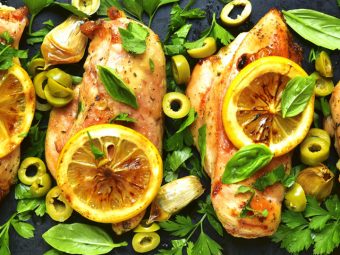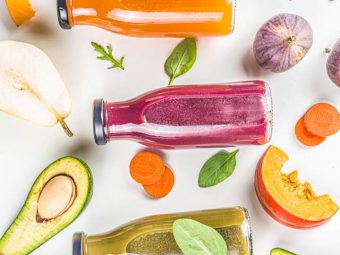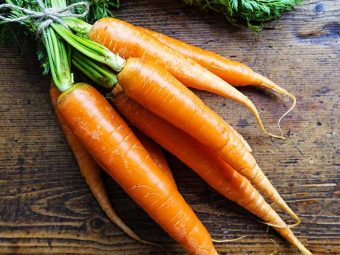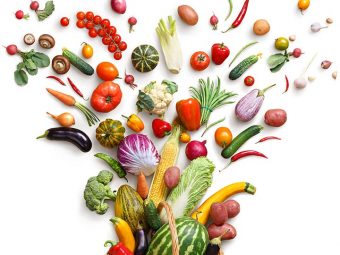Diabetes Diet Plan For Indians – What To Eat And Avoid
Everything you need to keep in mind about this specialised diet plan, including sample charts.

In India, over 41 million people have diabetes. It is estimated to increase to 70 million by 2025 (1), (2). No wonder India is called the diabetes capital of the world. But an Indian diet chart for people with diabetes may help reverse this trend to a great extent – as one of the root causes of diabetes type 2 is poor eating habits and a sedentary lifestyle.
Of course, genes also may play an important part. But revamping your lifestyle can increase the chances of reversing diabetes type 2. Continue reading to know what to eat if you have diabetes and the lifestyle changes you need to make. We also have included a diet chart for you. Scroll down.
In This Article
What Is Diabetes?
The WHO defines diabetes as a chronic metabolic disease that occurs when the body does not produce enough insulin or does not use insulin (insulin resistance) that is produced, resulting in elevated blood glucose levels (3).
How Does A Diabetes Diet Help Manage Blood Glucose Levels?
The management of diabetes needs a holistic approach that involves lifestyle management, along with good glycemic control and balanced nutrition to manage blood sugar levels. The right food choices often help manage blood sugar levels, improve blood cholesterol, and keep you in a healthy weight range. Always speak to a nutritionist and choose the right foods to control blood glucose levels.
Sample Indian Diet Chart For Diabetes
The Indian diabetes diet chart will ensure you have 1200-1600 calories per day, which is based on age, sex, type of diabetes, physical activity, and type of medication you are on.
North
| MEAL | FOODS TO EAT |
|---|---|
| Early Morning | Options:
|
| Breakfast | Options:
|
| Pre-Lunch | Options:
|
| Lunch | Options:
|
| Evening Snacks |
|
| Dinner | Options:
|
| Before Bed |
|
East
| MEAL | FOODS TO EAT |
|---|---|
| Early Morning | Options:
|
| Breakfast | Options:
|
| Pre-Lunch | Options:
|
| Lunch | Options:
|
| Evening Snacks | Options:
|
| Dinner | Options:
|
| Before Bed |
|
South
| MEAL | FOODS TO EAT |
|---|---|
| Early Morning | Options:
|
| Breakfast | Options:
|
| Pre-Lunch | Options:
|
| Lunch | Options:
|
| Evening Snacks | Options:
|
| Dinner | Options:
|
| Before Bed |
|
West
| MEAL | FOODS TO EAT |
|---|---|
| Early Morning | Options:
|
| Breakfast | Options:
|
| Pre-Lunch |
|
| Lunch | Options:
|
| Evening Snacks | Options:
|
| Dinner | Options:
|
| Before Bed |
|
In addition to the foods mentioned in the diet, you can consume the following:
Foods To Eat
- Healthy Fats
Not all fats are bad. Aim to limit your saturated fat intake and increase the intake of monounsaturated and polyunsaturated fatty acids in your diet. A recent clinical trial showed a positive correlation between PUFA intake and improvement in glycemic control (4). Both the quality and quantity of fat matter in the regulation of blood sugar levels.
Foods To Eat – Fish, fish liver oil, flaxseeds, sunflower seeds, pumpkin seeds, sesame seeds, walnuts, avocados, and oysters.
- Carbohydrates
Complex carbs with high fiber content are recommended for individuals with diabetes. A study on Chinese individuals with type 2 diabetes on a low-fat diet (LFD) and a low-carb diet (LCD) showed that LCD had better control over blood glucose levels as compared to LFD (5).
Whole grains contain fiber and help improve the glucose levels after a meal and maintain healthy insulin levels, according to a systematic review study (6). Avoid refined carbs with low to no fiber content.
Foods To Eat – Rye, oats, quinoa, millet, legumes, brown rice, wild rice, whole wheat, and low sugar bran flakes.
- Healthy Proteins
Consuming high-quality protein does not alter the post-meal increase in glucose levels. But a protein meal mixed with carbs increases insulin secretion, which can help regulate blood glucose levels (7). Include proteins with high biological value in each meal.
Foods To Eat – Lentils, Brussels sprouts, soy, kidney beans, tofu, hummus, pumpkin seeds, chicken, turkey, fish (sardines, mackerel, tilapia, catla, rohu, singi, magur, pomfret, cod liver oil, hilsa, tuna, and trout).
- Vegetables
Vegetables are good sources of vitamins, minerals, antioxidants, and fiber. Having at least two servings of vegetables (cooked or raw) a day will help you lose weight, boost your immunity, and develop good control over blood glucose levels. A study on Japanese individuals with T2DM revealed that the ‘eat vegetables before carbohydrates’ approach had better glycemic control than an exchanged based meal (8).
Foods To Eat – Spinach, sweet potatoes, cauliflower, peas, capsicum, gourds, onion, garlic, celery, asparagus, beans, brinjal, lettuce, zucchini, tomato, broccoli, and kale.
- Dairy
Dairy proteins (casein and whey protein) in milk, yogurt, and cheese exert a beneficial role in the management of diabetes by increasing insulin secretion (9). A cohort study established an inverse relationship between dairy intake and the prevalence rate of diabetes (10).
Foods To Eat – Low-fat milk, egg whites, non-fat yogurt, low-fat cottage cheese, low-fat or non-fat sour cream, and unflavored soy milk.
Functional Foods For Diabetes
Functional foods with bioactive compounds can have a beneficial effect in managing blood glucose levels. The list of superfoods are:
- Fenugreek
- Bitter gourd
- Psyllium husk
- Millets
- Brown rice
- Legumes
- Oats
- Quinoa
- Cinnamon
- Turmeric
- Nuts and oilseeds – Walnuts and flaxseeds
Lifestyle Changes For People With Diabetes
As per the American Diabetes Association, diabetes self-management education and support (DSMES), medical nutrition therapy (MNT), physical activity, smoking cessation counseling, and psychological care are the fundamental aspects to change blood glucose biomarkers (11).
Following a few practices, like waking up early, practicing yoga, working out, eating right, getting proper sleep, meditating, taking out time for yourself, going to bed early, etc., are a few changes that will bring positivity and happiness in your life.
The Indian diet chart for people with diabetes may help reverse the condition to a great extent. A holistic strategy that includes lifestyle management, effective glycemic control, and balanced nutrition is needed to control blood sugar levels. The appropriate meal choices can help you control your blood sugar, lower your cholesterol, and maintain a healthy weight. Consult a doctor and a nutritionist for advice tailored to your health and other medical conditions.
Frequently Asked Questions
I am 24 years old, and I have been diagnosed with diabetes. Does this mean I have to follow a restricted diet for the rest of my life?
It is not a “restricted diet” but rather a “controlled diet.” You can have anything you want, but keep a check on your daily sugar and salt intake. Yes, you need to avoid certain foods that, in general, do no good to anybody. Be active, avoid a sedentary lifestyle, and practice yoga.
Will drinking bitter gourd juice or neem juice help to treat diabetes?
Yes. Doctors recommend bitter gourd juice and neem juice for individuals with diabetes. There is scientific evidence that bitter gourd and neem help in lowering blood glucose levels. You can either have boiled bitter gourd or chew three or four neem leaves first thing in the morning.
Bitter gourd contains an insulin-like compound called polypeptide-p or p-insulin. This compound can control diabetes naturally. Neem leaves contain flavonoids, triterpenoids, glycosides, and antiviral compounds that may help manage blood sugar levels. However, overeating may have hypoglycemic effects.
I am 62 years old, and I cannot do heavy workouts. Please suggest any other alternative.
Start by going on long, lazy walks. Later, pick up the pace of your walks. You can also practice pranayama. Work with a yoga expert who will guide you.
How much weight will I lose?
Check with your doctor to know what your ideal weight should be according to your age, medical history, sex, current weight, bone mass, etc. Then, plan your daily diet accordingly to reach your ideal weight.
Is eucalyptus oil effective in treating diabetes? Where can I buy eucalyptus oil?
Yes, there is scientific evidence that eucalyptus oil helps reduce blood glucose levels. You can buy eucalyptus oil from various online stores. Mix four to five drops of eucalyptus oil in warm water or warm milk and drink it. Make sure not to add too much of eucalyptus oil as it might be toxic.
Which fruits should I eat?
Eat gooseberries, black plum (Jamun), apple, banana, guava (not ripe), raw papaya, etc. You can also eat fruits that have high fructose content such as mango, litchi, and grapes. But make sure not to overdo them.
Sources
- India – Diabetes capital of the world: Now heading towards hypertension, The Journal of the Association of Physicians of India, ResearchGate.
https://www.researchgate.net/publication/5995205_India_-_Diabetes_capital_of_the_world_Now_heading_towards_hypertension - Current scenario of diabetes in India, Journal of Diabetes, Wiley Online Library.
https://onlinelibrary.wiley.com/doi/full/10.1111/j.1753-0407.2008.00004.x - Diabetes, World Health Organization.
https://www.who.int/health-topics/diabetes - Polyunsaturated Fatty Acids and Glycemic Control in Type 2 Diabetes, Nutrients, US National Library of Medicine, National Institutes of Health.
https://www.ncbi.nlm.nih.gov/pmc/articles/PMC6566834/ - The Effect of Low-Carbohydrate Diet on Glycemic Control in Patients with Type 2 Diabetes Mellitus, Nutrients, US National Library of Medicine, National Institutes of Health.
https://www.ncbi.nlm.nih.gov/pubmed/29882884 - Whole Grain Intake and Glycaemic Control in Healthy Subjects: A Systematic Review and Meta-Analysis of Randomized Controlled Trials, Nutrients, US National Library of Medicine, National Institutes of Health.
https://www.ncbi.nlm.nih.gov/pmc/articles/PMC5537883/ - Plasma insulin responses after ingestion of different amino acid or protein mixtures with carbohydrate, The American journal of clinical nutrition, US National Library of Medicine, National Institutes of Health.
https://www.ncbi.nlm.nih.gov/pubmed/10871567/ - A simple meal plan of ‘eating vegetables before carbohydrate’ was more effective for achieving glycemic control than an exchange-based meal plan in Japanese patients with type 2 diabetes, Asia Pacific journal of clinical nutrition, US National Library of Medicine, National Institutes of Health.
https://www.ncbi.nlm.nih.gov/pubmed/21669583 - Dairy Foods and Dairy Proteins in the Management of Type 2 Diabetes: A Systematic Review of the Clinical Evidence, Advances in Nutrition, US National Library of Medicine, National Institutes of Health.
https://www.ncbi.nlm.nih.gov/pmc/articles/PMC4424779/ - Dairy consumption and risk of type 2 diabetes mellitus: a meta-analysis of cohort studies, European Journal of Clinical Nutrition, US National Library of Medicine, National Institutes of Health.
https://www.ncbi.nlm.nih.gov/pubmed/21559046/ - 5. Lifestyle Management: Standards of Medical Care in Diabetes—2019, American Diabetes Association.
https://care.diabetesjournals.org/content/42/Supplement_1/S46












